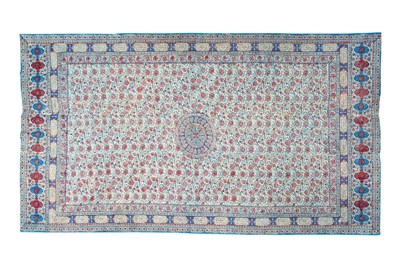28th Apr, 2023 14:00
Islamic & Indian Art
A LITURGICAL COTTON KALAMKARI BANQUETING CLOTH
The Armenian community of Julfa, Isfahan, Qajar Iran, 19th century
A LITURGICAL COTTON KALAMKARI BANQUETING CLOTH
PROPERTY FROM A PRIVATE WEST LONDON COLLECTOR
The Armenian community of Julfa, Isfahan, Qajar Iran, 19th century
Of large rectangular shape, the three pale blue loom-width lengths of cotton ground block-printed and hand-painted, mordant and resist-dyed in blue and madder red, the ground with a continuous scrolling design of frilled roses and parakeets around a central medallion of concentric design containing buti and cypress trees, the border with alternating blue and red bold floral cartouches against scrolling carnations, the inner border with repeating cartouches printed in black Armenian script with prayers reading ‘In the Name of the Father, the Son, and the Holy Spirit, Amen’, recited in the community to say grace before every meal, the word 'Amen' written in 4th-century grammar merging the 'A' and 'M' possibly to save space and balance the text, inner joints hand stitched, hems machine stitched, 384cm x 202cm.
Armenians have lived for millennia in the territory that forms modern-day Iran. Many ancient Armenian churches, monasteries, and chapels are located within the borders of this land. In more recent centuries, the ebbs and flows of regional political events have outlined the movements of these communities. As an example, during the Ottoman-Safavid war of 1602-1618, the Safavid Shah, Abbas I the Great relocated an estimated 500,000 Armenians from the Western territories of Tabriz and Lake Van region to the newly created Armenian quarter of Isfahan, known as New Julfa. The community that settled here became a fundamental player in the cultural and economic development of pre-modern Iran.
Mostly settled in territories now corresponding to Azerbaijan, Isfahan, Kurdistan, Luristan, and Tehran, the Iranian-Armenian communities enjoyed the freedom of worship and continued to build churches until the 1970s. The present banqueting cloth is a special reminder of the unique position of these people: respected and admired for their dexterity, it is unsurprising that Armenian artisans of New Julfa would have turned their hand to traditional Persian block printing and produced liturgical textiles for their Christian festivals and celebrations.
Sold for £1,000
Includes Buyer's Premium
Do you have an item similar to the item above? If so please click the link below to submit a free online valuation request through our website.







